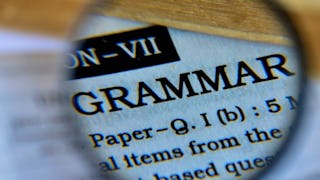In this course, “Word Forms and Simple Present Tense,” you will learn about different word forms, like nouns, proper nouns, plural forms and singular forms. You will learn when to use the articles “a” and “an.” You will also learn about the BE verb in English, how to form it and when to use it. Then you will learn how to form other verbs in the simple present, including some spelling rules, and how to make negative forms.

4 days left: Get a Black Friday boost with $160 off 10,000+ programs. Save now.


Word Forms and Simple Present Tense
This course is part of Learn English: Beginning Grammar Specialization


Instructors: Rachel Fernandez
154,389 already enrolled
Included with
(3,747 reviews)
Skills you'll gain
Details to know

Add to your LinkedIn profile
4 assignments
See how employees at top companies are mastering in-demand skills

Build your subject-matter expertise
- Learn new concepts from industry experts
- Gain a foundational understanding of a subject or tool
- Develop job-relevant skills with hands-on projects
- Earn a shareable career certificate

There are 4 modules in this course
In this first week, we will look at word forms. You learn about different kinds of words like nouns, verbs, and adjectives. Then you will learn about different kinds of nouns. You will learn about plural and singular nouns, how to make spelling changes, and when to use the articles “a” and “an.” You will also learn about verbs in the simple present. We will start with the BE verb. BE is very common. We use it all of the time.
What's included
4 videos3 readings1 assignment
This week, we will look at other verbs in the simple present. You will learn how to form and use the simple present. You will also learn about the different spelling changes that happen when you add an “s” to a verb in the simple present. You will also learn about possessive adjectives and the apostrophe “s” to show someone has something.
What's included
3 videos3 readings1 assignment
This week, you will learn more about the simple present. We will look at how to form the negative for the BE verb and for all other verbs. The BE verb always has rules that are different from other verbs. You will also learn how to use “There is” and “There are” to describe things in a place.
What's included
3 videos3 readings1 assignment
This week, we will start with how to ask yes/no questions using the BE verb. Then, you will practice asking questions using “Is there...?” and “Are there...?” Finally, You will learn how to use “do” and “does” to ask yes/no questions in the simple present.
What's included
3 videos3 readings1 assignment
Earn a career certificate
Add this credential to your LinkedIn profile, resume, or CV. Share it on social media and in your performance review.
Instructors

Offered by
Explore more from Learning English
 Status: Free Trial
Status: Free TrialUniversity of California, Irvine
 Status: Free Trial
Status: Free TrialUniversity of California, Irvine
 Status: Free Trial
Status: Free TrialUniversity of California, Irvine
 Status: Free Trial
Status: Free TrialUniversity of California, Irvine
Why people choose Coursera for their career




Learner reviews
3,747 reviews
- 5 stars
89.40%
- 4 stars
8.41%
- 3 stars
1.19%
- 2 stars
0.39%
- 1 star
0.58%
Showing 3 of 3747
Reviewed on Aug 31, 2021
Fue un curso excelente para iniciar a desarrollar habilidades en el idioma ingles. Las clases y lo ejercicios son faciles de entender y estan muy bien esplicados
Reviewed on Mar 15, 2022
i liked this course so much, and i'm so excited to complete the other courses to learn more and more about english grammar, especially basics
Reviewed on Oct 28, 2023
this course very easy to learn and very useful for everyone who is learning English. The instructors very kind. thankyou for your help.

Open new doors with Coursera Plus
Unlimited access to 10,000+ world-class courses, hands-on projects, and job-ready certificate programs - all included in your subscription
Advance your career with an online degree
Earn a degree from world-class universities - 100% online
Join over 3,400 global companies that choose Coursera for Business
Upskill your employees to excel in the digital economy
Frequently asked questions
To access the course materials, assignments and to earn a Certificate, you will need to purchase the Certificate experience when you enroll in a course. You can try a Free Trial instead, or apply for Financial Aid. The course may offer 'Full Course, No Certificate' instead. This option lets you see all course materials, submit required assessments, and get a final grade. This also means that you will not be able to purchase a Certificate experience.
When you enroll in the course, you get access to all of the courses in the Specialization, and you earn a certificate when you complete the work. Your electronic Certificate will be added to your Accomplishments page - from there, you can print your Certificate or add it to your LinkedIn profile.
Yes. In select learning programs, you can apply for financial aid or a scholarship if you can’t afford the enrollment fee. If fin aid or scholarship is available for your learning program selection, you’ll find a link to apply on the description page.
More questions
Financial aid available,

